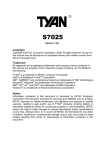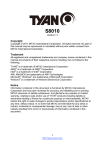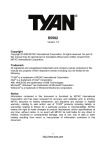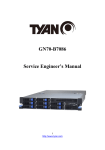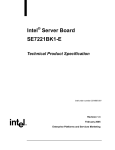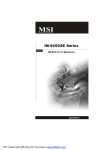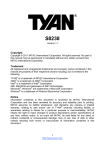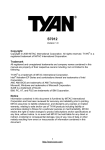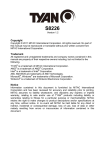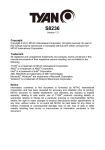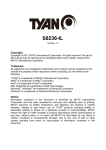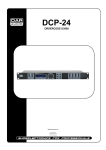Download Tyan S8230GM4NR
Transcript
S8230 Version 1.01 Copyright Copyright © 2010 MiTAC International Corporation. All rights reserved. No part of this manual may be reproduced or translated without prior written consent from MiTAC International Corporation. Trademark All registered and unregistered trademarks and company names contained in this manual are property of their respective owners including, but not limited to the following. ® TYAN is a trademark of MiTAC International Corporation. ® ® AMD is a trademark of AMD Corporation. ® ® Intel is a trademark of Intel Corporation. AMI, AMI BIOS are trademarks of AMI Technologies. ® ® Microsoft , Windows are trademarks of Microsoft Corporation. ® Winbond is a trademark of Winbond Electronics Corporation. Notice Information contained in this document is furnished by MiTAC International Corporation and has been reviewed for accuracy and reliability prior to printing. MiTAC assumes no liability whatsoever, and disclaims any express or implied ® warranty, relating to sale and/or use of TYAN products including liability or warranties relating to fitness for a particular purpose or merchantability. MiTAC retains the right to make changes to product descriptions and/or specifications at any time, without notice. In no event will MiTAC be held liable for any direct or indirect, incidental or consequential damage, loss of use, loss of data or other malady resulting from errors or inaccuracies of information contained in this document. 2 http://www.tyan.com Contents Before you begin… .................................................................................... 4 Chapter 1: Instruction ................................................................................ 5 1.1 Congratulations ................................................................................. 5 1.2 S8230 Hardware Specifications ........................................................ 5 1.3 Software Specifications ..................................................................... 8 Chapter 2: Board Installation..................................................................... 9 2.1 Board Image .................................................................................... 10 2.2 Block Diagram ................................................................................. 11 2.3 Board Parts, Jumpers and Connectors ........................................... 12 2.4 Installing the Processor and Heat sink ............................................ 24 2.5 Thermal Interface Material............................................................... 27 2.6 Tips on Installing Motherboard in Chassis ...................................... 28 2.7 Installing the Memory ...................................................................... 30 2.8 Attaching Drive Cables .................................................................... 35 2.9 Installing Add-In Cards .................................................................... 36 2.10 Connecting External Devices ........................................................ 37 2.11 Installing the Power Supply ........................................................... 38 2.12 Finishing Up ................................................................................... 39 Chapter 3: BIOS Setup ............................................................................. 40 3.1 3.2 3.3 3.4 3.5 3.6 3.7 3.8 About the BIOS ................................................................................ 40 Main Menu ....................................................................................... 42 Advanced Menu............................................................................... 43 PCI/PnP Menu ................................................................................. 66 Boot Menu ....................................................................................... 68 Security Menu .................................................................................. 70 Chipset Menu .................................................................................. 72 Exit Menu ......................................................................................... 80 Chapter 4: Diagnostics ............................................................................. 82 4.1 Beep Codes ..................................................................................... 82 4.2 Flash Utility ...................................................................................... 82 4.3 AMIBIOS Post Code ........................................................................ 83 Glossary..................................................................................................... 86 3 http://www.tyan.com Before you begin… Check the box contents! The retail motherboard package should contain the following: 1x S8230 Motherboard 6 x Serial ATA Cable 1 x USB2.0 cable 1 x S8230 User’s manual 1 x S8230 Quick reference guide ® 1 x TYAN Driver CD 1 x I/O shield 2 x mini SAS Cable 4 http://www.tyan.com Chapter 1: Instruction 1.1 Congratulations ® You have purchased the powerful TYAN S8230 motherboard, based on the ® ® AMD SP5100 chipset. The S8230 is designed to support dual AMD 45nm 8Core/12-Core Opteron 6100 Series Processors and up to 256GB of 800, 1066 and 1333MHz UNB or REG/ECC DDR3 memory, as well as low-voltage DDR3 ® memory modules. Leveraging advanced technology from AMD , the S8230 is capable of offering scalable 32 and 64-bit computing, high-bandwidth memory design, and lightning-fast PCI-E bus implementation. The S8230 not only empowers you in today’s demanding IT environment but also offers a smooth path for future application upgradeability. All of these rich feature sets provides the S8230 with the power and flexibility to meet demanding requirements for today’s IT environments. ® Remember to visit the TYAN website at http://www.tyan.com. There you can ® find all the information on all TYAN products as well as all the supporting documentation, FAQs, Drivers and BIOS upgrades. 1.2 S8230 Hardware Specifications Processor Chipset Memory Expansion Slots Supported CPU AMD 45nm 8-Core/12-Core Opteron 6100 Series Series Processors (Magny-Cours) Socket Type / Q'ty G34 1944-pin / (2) Average CPU Power Up to 105W (ACP) wattage Up to 6.4 GT/s Hyper-Transport link support / (4) System Bus HT3; 12MB L3 per socket Chipset AMD SR5690 (5670) + SP5100 Super I/O Winbond W83627 DIMM slot Qty (8)+(8) DIMM slots DIMM Type / Speed U/RDDR3 & LV RDDR3, 800/1066/1333MHz Capacity Up to 256GB Memory channel 4 Channels per CPU Memory voltage 1.35V/ 1.5V (1) PCI-E Gen.2 x8 slot (w/ x4 link) (1) PCI-E Gen.2 x8 slot PCI-E (1) PCI-E Gen.2 x16 slot (w/ x16 or x8 link) (1) PCI-E Gen.2 x8 slot (w/ x0 or x8 link) PCI (2) PCI 32-bit slots 5 http://www.tyan.com Recommended Barebones / Chassis LAN 1U Barebones GT62-B8230-LE Port Q'ty Controller Connector Speed RAID Connector Controller SATA Speed RAID (4) (2) Intel 82574L / (2) Intel 82576EB (2) Mini-SAS connectors (support 4 HDD’s/cable) LSI SAS2008 (for S8230WGM4NR and S8230WGM4NR-LE only) 6.0 Gb/s RAID 0/1/1E/10 (LSI Integrated RAID) (6) SATA AMD SP5100 3.0 Gb/s RAID 0/1/10/5 (Promise Integrated RAID) Connector type D-Sub 15-pin Resolution 1600x1200@60Hz Chipset Aspeed AST2050 SAS Storage Graphic Controller USB Input /Output COM SAS VGA RJ-45 Power Front Panel SATA Chipset Voltage Fan System Monitoring Temperature LED Server Management BIOS Others Onboard Chipset AST2050 IPMI Feature AST2050 iKVM Feature Brand / ROM size (6) USB2.0 ports (2 at rear, 2 via cable, 2 Vertical [Type A] onboard) (2) ports (1 at rear, 1 via cable) (2) Mini-SAS (4-in-1) connectors (1) D-Sub 15-pin VGA port (4) GbE ports ATX12V / Universal 24-pin + 8-pin + 8-pin power connectors (1) 2x12-pin SSI front panel header (6) SATA-II connectors Winbond W83793G Monitors voltage for CPU, memory, chipset & power supply (12) Total ((7) 4-pin headers + (5) 8-pin headers) Monitors temperature for CPU & system environment Fan fail LED indicator / Over temperature warning indicator / Fan & PSU fail LED indicator Watchdog timer support Onboard Aspeed AST2050 IPMI 2.0 compliant baseboard management controller (BMC) / USB 2.0 virtual hub 24-bit high quality video compression / Dual 10/100 Mb/s MAC interfaces AMI / 4MB 6 http://www.tyan.com Feature Form Factor Board Dimension Operating System OS supported list FCC (DoC) Regulation CE (DoC) Operating Temp. Non-operating Operating Temp. Environment In/Non-operating Humidity RoHS RoHS 6/6 Complaint Motherboard Manual Installation CD Package Contains I/O Shield SATA Cable SAS Physical Dimension Optional accessories Riser Card Plug and Play (PnP) /PCI2.3 /WfM2.0 /SMBIOS2.3 /PXE boot / ACPI 2.0 power management /Power on mode after power recovery / User-configurable H/W monitoring E-ATX 12"x13" (305x330mm) Please visit our web site for the latest update. Class B Yes 10° C ~ 35° C (50° F~ 95° F) - 40° C ~ 70° C (-40° F ~ 158° F) 90%, non-condensing at 35° C Yes (1) S8230 Motherboard (1) User's manual / (1) Quick Ref. Guide (1) TYAN installation CD (1) I/O Shield (6) SATA signal cables (2) mini-SAS cables (for S8230WGM4NR and S8230WGM4NR-LE only) M2091, PCI-E x16 1U riser card (left) 7 http://www.tyan.com S8230 SKU Comparison Table S8230WGM4NR S8230GM4NR Yes Yes AMD SP5100 Yes Yes BMC (AST2050) Yes Yes Yes Yes LSA2008 SAS Yes Memory DIMM 16 PCIE Slots 4 4 2 2 VGA Yes Yes Yes Yes COM Yes Yes Yes Yes SATAII Ports 6 6 6 6 AMD SR5690 AMD SR5670 S8230WGM4NR-LE S8230GM4NR-LE Yes Yes Yes Yes Yes 16 16 16 1.3 Software Specifications ® For OS (operation system) support, please check with TYAN support for latest information. Remember to visit our Web site at http://www.tyan.com for the latest AST2050 User’s Guide. 8 http://www.tyan.com Chapter 2: Board Installation You are now ready to install your motherboard. How to install our products right… the first time The first thing you should do is reading this user’s manual. It contains important information that will make configuration and setup much easier. Here are some precautions you should take when installing your motherboard: (1) Ground yourself properly before removing your motherboard from the antistatic bag. Unplug the power from your computer power supply and then touch a safely grounded object to release static charge (i.e. power supply case). For the safest conditions, MiTAC recommends wearing a static safety wrist strap. (2) Hold the motherboard by its edges and do not touch the bottom of the board, or flex the board in any way. (3) Avoid touching the motherboard components, IC chips, connectors, memory modules, and leads. (4) Place the motherboard on a grounded antistatic surface or on the antistatic bag that the board was shipped in. (5) Inspect the board for damage. The following pages include details on how to install your motherboard into your chassis, as well as installing the processor, memory, disk drives and cables. NOTE: Do not apply power to the board if it has been damaged. 9 http://www.tyan.com 2.1 Board Image This picture is representative of the latest board revision available at the time of publishing. The board you receive may not look exactly like the above picture. 10 http://www.tyan.com 2.2 Block Diagram S8230 Block Diagram 11 http://www.tyan.com 2.3 Board Parts, Jumpers and Connectors This diagram is representative of the latest board revision available at the time of publishing. The board you receive may not look exactly like the above diagram. But for the DIMM number please refer to the above placement for memory installation. For the latest board revision, please visit our web site at http://www.tyan.com. 12 http://www.tyan.com Jumpers & Connectors Jumper/Connector J7/J42/J43/J89/J91 J83/J84/J85/J86/J90 J55/J9 J93 J8 (COM2) J17/J19 J18 J41/J77 J50/J56/J51/J57/J52/J58 J64 J66 J88 LED1 USB1 JP6 JP7 JP8 JP13 JP16 JP19 JP21 JP22 JP23 JP24 JP25 Function 4-pin Fan Connectors 8-pin 4056 FAN Connector (Barebones use only) 4-pin CPU0/CPU1 Fan Header 2x10 pin Fan Connector (Barebones use only) COM2 Header Mini-SAS Connector IPMB Connector Vertical [Type A] USB Connectors SATA0/SATA1/SATA2/SATA3/SATA4/SATA5 Front Panel Connector SAS Fault LED PSMI Connector ID LED USB Front Panel Header SAS Enable/Disable Jumper PCI-E Width Switch for Slot5 and Slot 6 Clear CMOS Jumper TPM Enable/Disable Jumper Chassis Intrusion Header BMC VGA Enable/Disable Jumper CPU0 Memory Voltage Select Jumper CPU1 Memory Voltage Select Jumper LAN4 Active LED LAN2 Active LED ID LED Header Jumper Legend OPEN - Jumper OFF Without jumper cover CLOSED - Jumper ON With jumper cover 13 http://www.tyan.com J43 J89 J9 J84 J83 J91 J85 J55 J86 J7 J18 J90 J42 J93 14 http://www.tyan.com J7/J42/J43/J89/J91: 4-Pin FAN Connectors Pin 1 2 3 4 Signal GND +12V Tachometer PWM Control Use this header to connect the cooling fan to your motherboard to keep the system stable and reliable. J55/J9: 4-pin CPU0/CPU1 Fan Connectors Pin Signal 1 2 3 4 GND +12V Tachometer Fan PWM (Speed) Control J83/J84/J85/J86/J90: 8-pin 4056 Fan Header (Barebones use only) Signal PWM1 TACH1 GND +12V Pin 1 3 5 7 Pin 2 4 6 8 Signal +12V GND TACH2 PWM2 NOTE: Do not mix 8-pin Fan headers with 4-pin Fan headers. Mixing these fan headers will cause problems to the system. J93: 2x10-Pin FAN connector for TYAN (Barebones use only) Signal Pin Pin Signal FANIN1 FANIN2 FANIN3 FANIN4 FANIN5 GND FANCTL5 FANIN11 FANIN12 N/C 1 3 5 7 9 11 13 15 17 19 2 4 6 8 10 12 14 16 18 20 FANIN6 FANIN7 FANIN8 FANIN9 FANIN10 KEY FANCTL4 N/C N/C FANCTL7 J18: IPMB Connector Signal IPMB_DATA IPMB_CLK Pin 1 3 15 http://www.tyan.com Pin 2 4 Signal GND N/C J88 J8 J64 USB1 J41 16 http://www.tyan.com J77 USB1: USB Front Panel Connector Signal PWR_5V USB_N1 USB_P1 GND KEY Pin 1 3 5 7 9 Pin 2 4 6 8 10 Signal PWR-5V USB_N2 USB_P2 GND N/C J41/J77: Vertical (Type A) USB Connectors Pin Signal 1 2 3 4 +5V USB D- USB D+ GND J88: PSMI Connector Pin Signal 1 2 3 4 5 SMB_CLK SMB_DAT SMBALERT GND V3P3 J64: TYFP1 Connector Signal Pin Pin Signal Power LED+ KEY Power LED HD LED+ HD LED Power SW GND Reset SW GND ID SW TEMP Sensor NMI 1 3 5 7 9 11 13 15 17 19 21 23 2 4 6 8 10 12 14 16 18 20 22 24 PWR System ID LED+ System ID LEDFault LED PSU Fault LED LAN1 LED + LAN1 LED SMB Host Data SMB Host CLK INTRU# LAN3 LED + LAN3 LED - J8: COM2 Connector Signal DCD RXD TXD DTR GND Pin 1 3 5 7 9 17 http://www.tyan.com Pin 2 4 6 8 10 Signal DSR RTS CTS RI KEY JP25 LED1 JP24 JP23 18 http://www.tyan.com J66 J66: SAS Fault LED Use this header to connect to the CPLD firmware update tool Signal Pin Pin SAS Fault LED 0 1 2 Signal SAS Fault LED 1 SAS Fault LED 2 3 4 SAS Fault LED 3 SAS Fault LED 4 5 6 SAS Fault LED 5 KEY 7 8 SAS Fault LED 7 SAS Fault LED 6 9 10 Ground JP23: LAN4 LED Header 1 Pin 1 2 Signal LAN4 LED+ LAN4 LED- Pin 1 2 Signal LAN2 LED+ LAN2 LED- Pin 1 2 Signal ID LED+ ID LED- JP24: LAN2 LED Header 1 JP25: ID LED Header 1 LED1: ID LED Pin Signal + P3V3_AUX ID_SW_L State Color Description On Blue System identified Off Off System not identified NOTE: IPMI can activate ID LED from remote site. Please visit the TYAN Web Site at http://www.tyan.com to download the latest AST2050 Software Configuration Guide for IPMI settings. 19 http://www.tyan.com J58 J52 J57 J51 J56 J50 JP8 JP6 JP7 20 http://www.tyan.com J50/J56/J51/J57/J52/J58: SATA Connector 7 GND 6 RXP 5 RXN 4 GND 3 TXN 2 TXP 1 GND Connects to the Serial ATA ready drives via the Serial ATA cable. SATA0: J50 SATA2: J51 SATA4: J52 SATA1: J56 SATA3: J57 SATA5: J58 JP6: SAS Enable/Disable Jumper Open: Normal (Default) Closed: Disable on-board SAS function JP7: PCIE Switch for Slot #6 (PCI-E1) and Slot #5 (PCI-E2) Open: Normal(Default) NOTE: If there is no device in PCI-E2, then PCI-E1 can support up to a x16 PCI-E signal. If there is a device in PCI-E2 then PCIe1 can only support up to x8 PCI-E signal Closed: Force PCI-E1 to max x8 PCI-E signal JP8: Clear CMOS Jumper 1 Normal (Default) 1 Clear CMOS You can reset CMOS by using this jumper if you have forgotten your system/setup password or need to clear BIOS setting. 1. Power off system and disconnect both power connectors from the motherboard. 2. Put jumper cap back to Pin_1 and Pin_2 (default setting). 3. Use jumper cap to close Pin_2 and Pin_3 for seconds to Clear CMOS. 4. Reconnect power & power on system. 21 http://www.tyan.com JP21 JP22 JP13 JP19 JP16 22 http://www.tyan.com JP13: TPM Enable/Disable Jumper Open: Normal (Default) Closed: Disable TPM functions. JP16: Chassis Intrusion Header 1 Open: Use this jumper to disable the system chassis intrusion alarm. Closed: Use this jumper to trigger the system chassis intrusion alarm. (Default) Pin Signal 1 INTRUDER# 2 GND JP19: BMC VGA Enable/Disable Jumper Open: Normal (Default) Closed: Disable onboard VGA function. JP21: Low Voltage (1.35V) DDR3 Enable/Disable for CPU0 Jumper Open: Support regular 1.5V DDR3 memory (Default) Closed: Support for Low Voltage 1.35V DDR3 memory JP22: Low Voltage (1.35V) DDR3 Enable/Disable for CPU1 Jumper Open: Support regular 1.5V DDR3 memory (Default) Closed: Support for Low Voltage 1.35V DDR3 memory 23 http://www.tyan.com 2.4 Installing the Processor and Heat sink ® The S8230 supported AMD processors are listed in section 1.2 S8230 Hardware Specifications on page 4. Check our website at http://www.tyan.com for latest processor support. NOTE: MiTAC is not liable for damage as a result of operating an unsupported configuration. Processor Installation (G34 1944-pin Socket for AMD CPU) Follow the steps below to install the processors and heat sinks. 1. Locate the CPU socket. 2. Pull the CPU lever slightly away from the socket and then push it to a fully open position. 24 http://www.tyan.com 3. Lift the socket cover to a fully open position. 4. Take off the CPU protection cap. 5. Place the CPU in the CPU socket. 25 http://www.tyan.com 6. Close the socket cover and press the CPU socket lever down to lock the CPU in place. 7. Repeat the same procedures to install the second CPU. Heat sink Installation After installing the processor, you should proceed to install the heat sink. The CPU heat sink will ensure that the processor do not overheat and continue to operate at maximum performance for as long as you own them. The overheated processor is dangerous to the motherboard. For the safest method of installation and information on choosing the appropriate ® ® heat sink, using heat sinks validated by AMD . Please refer to the AMD website: http://www.amd.com The following diagram illustrates how to install heat sink onto the CPU of S8230. 8. Place the heat sink on top of the CPU and secure it to the motherboard with 2 screws. 9. 10. Connect the heat sink Fan cable to the CPU0 FAN connector J55. Repeat the same procedures to install the second heat sink (CPU1 FAN Connector J9). 26 http://www.tyan.com 2.5 Thermal Interface Material There are two types of thermal interface materials designed for use with the processors. The most common material comes as a small pad attached to the heat sink at the time of purchase. There should be a protective cover over the material. Take care not to touch this material. Simply remove the protective cover and place the heat sink on the processor. The second type of interface material is usually packaged separately. It is commonly referred to as ‘thermal compound’. Simply apply a thin layer on to the CPU lid (applying too much will actually reduce the cooling). NOTE: Always check with the manufacturer of the heat sink & processor to ensure that the thermal interface material is compatible with the processor and meets the manufacturer’s warranty requirements. 27 http://www.tyan.com 2.6 Tips on Installing Motherboard in Chassis Before installing your motherboard, make sure your chassis has the necessary motherboard support studs installed. These studs are usually metal and are gold in color. Usually, the chassis manufacturer will pre-install the support studs. If you are unsure of stud placement, simply lay the motherboard inside the chassis and align the screw holes of the motherboard to the studs inside the case. If there are any studs missing, you will know right away since the motherboard will not be able to be securely installed. 28 http://www.tyan.com Some chassis include plastic studs instead of metal. Although the plastic studs are usable, MiTAC recommends using metal studs with screws that will fasten the motherboard more securely in place. Below is a chart detailing what the most common motherboard studs look like and how they should be installed. 29 http://www.tyan.com 2.7 Installing the Memory Before installing memory, ensure that the memory you have is compatible with the motherboard and processor. Check the TYAN Web site at: www.tyan.com for details of the type of memory recommended for your motherboard. The following diagram shows common types of DDR3 memory modules. • Supports up to 256GB total of U/RDDR3 and LV RDDR3 at 800,1066 or 1333MHz speeds • All installed memory will automatically be detected and no jumpers or settings need changing • All memory must be of the same type and density • Always populate the memory starting from DIMM A1 first Recommended Memory Population Table Memory Configuration Chart CPU0 # of DIMM'S 1 DIMM 2 DIMM 4 DIMM 8 DIMM Channel 1 Channel 2 CPU1 Channel 3 Channel 4 Channel 1 Channel 2 Channel 3 Channel 4 A1 A0 B1 B0 C1 C0 D1 D0 A1 A0 B1 B0 C1 C0 D1 D0 X X X X X X X X X X X X X X X X X X X X X 30 http://www.tyan.com X X X X X X X X X U-DIMM Module Support DDR3 Speed/Voltage 1.35v 1.5v 800MHz 800MHz 800MHz 800MHz 1066MHz 1066MHz 1066MHz 1066MHz n/a 1333MHz n/a 1333MHz DDR3 Rank Configuration DIMM0 DIMM1 (A0, B0, (A1, B1, C0, D0) C1, D1) SR and DR SR and SR and DR DR SR and DR SR and SR and DR DR SR and DR SR and SR and DR DR Notes: • UDIMM can support up to 4GB sized DIMM’s • Maximum of 8GB per channel • SR and DR UDDR3 module support only • SR and DR 1.35v Memory MAX speed of 1066MHz in a dual channel configuration • SR and DR 1.5v Memory MAX speed of 1333MHz in a dual channel configuration 31 http://www.tyan.com R-DIMM Module Support DDR3 Speed/Voltage DDR3 Rank Configuration 1.35v 1.5v DIMM0 (A0, B0, C0, D0) DIMM1 (A1, B1, C1, D1) 800MHz 800MHz n/a SR and DR 800MHz 800MHz n/a QR 800MHz 800MHz SR, DR and QR SR, DR and QR 1066MHz 1066MHz n/a SR and DR 1066MHz 1066MHz n/a QR 1066MHz 1066MHz SR and DR SR and DR n/a 1066MHz QR SR, DR and QR n/a 1066MHz SR, DR and QR QR n/a 1333MHz n/a SR and DR n/a 1333MHz n/a QR n/a 1333MHz SR and DR SR and DR Notes: • RDIMM can support up to 16GB sized DIMM’s • SR and DR Memory has a MAX amount of 16GB per channel • SR and DR 1.35v Memory MAX speed of 1066MHz in a dual channel configuration • SR and DR 1.5v Memory MAX speed of 1333MHz in a dual channel configuration • QR Memory has a MAX amount of 32GB per channel • QR 1.35v Memory MAX speed of 800MHz in a dual channel configuration • QR 1.5v Memory MAX speed of 1066MHz in a dual channel configuration 32 http://www.tyan.com 33 http://www.tyan.com Memory Installation Procedure Follow these instructions to install memory modules into the S8230. 1. Press the locking levers in the direction shown in the following illustration. 2. Align the memory module with the socket. The memory module is keyed to fit only one way in the socket. KEY SLOT 3. Seat the module firmly into the socket by gently pressing down until it sits flush with the socket. The locking levers pop up into place. 34 http://www.tyan.com 2.8 Attaching Drive Cables Attaching Serial ATA Cables S8230 is equipped with 6 Serial ATA (SATA) channels. Connections for the drives are very simple. There is no need to set Master/Slave jumpers on SATA drives. If you are in need of SATA/SAS cables or power adapters please contact your place of purchase. The following pictures illustrate how to connect an SATA drive. 1. SATA drive cable connection 2. SATA drive power connection 3. SATA cable motherboard connector 4. SATA drive power adapter 35 http://www.tyan.com 2.9 Installing Add-In Cards Before installing add-in cards, it’s helpful to know if they are fully compatible with your motherboard. For this reason, we’ve provided the diagrams below, showing the slots that may appear on your motherboard. PCI-E Gen. 2 x 16 slot (x16 signal) PCI-E x8 slot (x8 signal) PCI 32/33MHz slot Simply find the appropriate slot for your add-in card and insert the card firmly. Do not force any add-in cards into any slots if they do not seat in place. It is better to try another slot or return the faulty card rather than damaging both the motherboard and the add-in card. TIP: It’s a good practice to install add-in cards in a staggered manner rather than making them directly adjacent to each other. Doing so allows air to circulate within the chassis more easily, thus improving cooling for all installed devices. NOTE: You must always unplug the power connector to the motherboard before performing system hardware changes to avoid damaging the board or expansion device. 36 http://www.tyan.com 2.10 Connecting External Devices Connecting external devices to the motherboard is an easy task. The motherboard supports a number of different interfaces through connecting peripherals. See the following diagrams for the details. Connect to Connect to 82574 & LAN 82576 & LAN LED4 (IPMI LED2 shared LAN) 2 X USB ports COM Port VGA Port Connect to 82574 & LAN LED1 Connect to 82576 & LAN LED3 NOTE: Peripheral devices can be plugged straight into any of these ports but software may be required to complete the installation. Onboard LAN LED Color Definition The two onboard Ethernet ports have green and yellow LEDs to indicate LAN status. The chart below illustrates the different LED states. 10/100/1000 Mbps LAN Link/Activity LED Scheme Link Active Link 100 Mbps Active Link 1000 Mbps Active No Link 10 Mbps Left LED Right LED Green Blinking Green Green Blinking Green Green Blinking Green Off Off Off Green Green Yellow Yellow Off 37 http://www.tyan.com 2.11 Installing the Power Supply There are three power connectors on your S8230. It is required that you have an EPS12V power supply which has one 24-pin and two 8-pin connectors. 24-pin (PW1) Signal Pin Pin Signal +3.3V 1 13 +3.3V +3.3V 2 14 -12V GND 3 15 GND +5V 4 16 PS_ON GND 5 17 GND +5V 6 18 GND GND 7 19 GND PS_GD 8 20 N/C 5VSB 9 21 +5V +12V 10 22 +5V +12V 11 23 +5V +3.3V 12 24 GND 8-pin (PW2, PW3) Signal Pin Pin Signal GND 1 5 +12V GND 2 6 +12V GND 3 7 +12V GND 4 8 +12V NOTE: Please be aware that ATX 2.x, ATX12V and ATXGES power supplies may not be compatible with the board and can damage the motherboard and/or CPU(s). Applying power to the board: Connect the EPS12V 8-pin power connectors. Both PW2 and PW3 are for CPU loading. With light load processors, such as HE model, one 8-pin connector is OK. With SE model processors, both 8-pin power connectors are required. Connect the EPS/12V 24-pin power connector. Connect power cable to power supply and power outlet. NOTE: You must unplug the power supply before plugging the power cables to motherboard connectors. 38 http://www.tyan.com 2.12 Finishing Up Congratulations on making it this far! You have finished setting up the hardware aspect of your computer. Before closing up your chassis, make sure that all cables and wires are connected properly, especially IDE cables and most importantly, jumpers. You may have difficulty powering on your system if the motherboard jumpers are not set correctly. In the rare circumstance that you have experienced difficulty, you can find help by asking your vendor for assistance. If they are not available for assistance, please find setup information and documentation online at our website or by calling your vendor’s support line. 39 http://www.tyan.com Chapter 3: BIOS Setup 3.1 About the BIOS The BIOS is the basic input/output system, the firmware on the motherboard that enables your hardware to interface with your software. The BIOS determines what a computer can do without accessing programs from a disk. The BIOS contains all the code required to control the keyboard, display screen, disk drives, serial communications, and a number of miscellaneous functions. This chapter describes the various BIOS settings that can be used to configure your system. The BIOS section of this manual is subject to change without notice and is provided for reference purposes only. The settings and configurations of the BIOS are current at the time of print and are subject to change, and therefore may not match exactly what is displayed on screen. This section describes the BIOS setup program. The setup program lets you modify basic configuration settings. The settings are then stored in a dedicated, batterybacked memory (called NVRAM) that retains the information even when the power is turned off. To start the BIOS setup utility: 1. Turn on or reboot your system. 2. Press <Del> during POST (F4 on remote console) to start the BIOS setup utility. 3.1.1 Setup Basics The table below shows how to navigate in the setup program using the keyboard. Key Function Tab Moves from one selection to the next Left/Right Arrow Keys Changes from one menu to the next Up/Down Arrow Keys Moves between selections Enter Opens highlighted section PgUp/PgDn Keys Changes settings. 40 http://www.tyan.com 3.1.2 Getting Help Pressing [F1] will display a small help window that describes the appropriate keys to use and the possible selections for the highlighted item. To exit the Help Window, press [ESC] or the [F1] key again. 3.1.3 In Case of Problems If you have trouble booting your computer after making and saving the changes with the BIOS setup program, you can restart the computer by holding the power button down until the computer shuts off (usually within 4 seconds); resetting by pressing CTRL-ALT-DEL; or clearing the CMOS. The best advice is to only alter settings that you thoroughly understand. In particular, do not change settings in the Chipset section unless you are absolutely sure of what you are doing. The Chipset defaults have been carefully chosen either by MiTAC or your system manufacturer for best performance and reliability. Even a seemingly small change to the Chipset setup options may cause the system to become unstable or unusable. 3.1.4 Setup Variations Not all systems have the same BIOS setup layout or options. While the basic look and function of the BIOS setup remains more or less the same for most systems, the appearance of your Setup screen may differ from the charts shown in this section. Each system design and chipset combination requires a custom configuration. In addition, the final appearance of the Setup program depends on the system designer. Your system designer may decide that certain items should not be available for user configuration, and remove them from the BIOS setup program. NOTE: The following pages provide the details of BIOS menu. Please be noticed that the BIOS menu are continually changing due to the BIOS updating. The BIOS menu provided are the most updated ones when this manual is written. Please visit TYAN’s website at http://www.tyan.com for the information of BIOS updating. 41 http://www.tyan.com 3.2 Main Menu In this section, you can alter general features such as the date and time. Note that the options listed below are for options that can directly be changed within the Main Setup screen. AMIBIOS It displays the core number, date of BIOS build and the version of BIOS. Processor This displays the CPU information. System Memory This displays the amount of system memory present on the system. System Time / Date setup System Time: Adjusts the system clock. HH (24 hours format): MM (Minutes): SS (Seconds) System Date: Adjusts the system date. MM (Months): DD (Days): YYYY (Years) 42 http://www.tyan.com 3.3 Advanced Menu This section facilitates configuring advanced BIOS options for your system. CPU Configuration Configure CPU. IDE Configuration Configure the IDE devices. Super IO Configuration Configure the Super IO. ACPI Configuration Selection for Advanced ACPI Configuration. Hardware Health Configuration Configure / monitor the Hardware Health. IPMI 2.0 Configuration IPMI configuration including server monitoring and event log. MPS Configuration 43 http://www.tyan.com Configure the Multi-Processor Table. PCI Express Configuration Configure PCI Express Support. Remote Access Configuration Configure Remote Access. USB Configuration Configure the USB support. 44 http://www.tyan.com 3.3.1 Advanced CPU Configuration This section allows you to fine-tune the processor options. GART Error Reporting This option should remain disabled for normal operation. The driver developer may enable it for the purpose of testing. Disabled / Enabled Microcode Update Disabled / Enabled Secure Virtual Machine Mode Disabled / Enabled PowerNow Enable/disable the generation of ACPI_PPC, _PSS, and _PCT objects. Disabled / Enabled PowerCap The option can decide the highest performance P-state in OS. P-state 0 / P-state 1 / P-state 2 / P-state 3 / P-state 4 45 http://www.tyan.com ACPI SRAT Table Enable or disable the building of ACPI SRAT Table. Disabled / Enabled CPU Prefetching Enable or disable CPU prefetching. Disabled / Enabled IO Prefetching Enable or disable IO prefetching. Disabled / Enabled Probe Filter Initialization mode for Probe Filter. Auto / Disable / MP Mode 46 http://www.tyan.com 3.3.2 Advanced IDE Configuration Onboard PCI IDE Controller Disabled: disables the integrated IDE Controller Primary: enables only the Primary IDE Controller Secondary: enables only the Secondary IDE Controller Both: enables both IDE Controller Disabled / Primary / Secondary / Both Primary/Secondary/Third/Fourth IDE Master While entering setup, BIOS auto detects the presence of IDE devices. displays the status of auto detection of IDE devices. This Hard Disk Write Protect Disable/Enable device write protection. This will be effective only if device is accessed through BIOS. Disabled / Enabled IDE Detect Time Out (Sec) Select the time out value for detecting ATA/ATAPI device(s). 0~35 (at 5 interval) ATA(PI) 80Pin Detection 47 http://www.tyan.com Select the mechanism for detecting 80Pin ATA(PI) Cable. Host & Device / Host / Device 48 http://www.tyan.com 3.3.3 Super I/O Configuration Serial Port1 Address Allows BIOS to configure Serial Port1 Base Address. Disabled / 3F8/IRQ4 / 2E8/IRQ3 Serial Port2 Address Allows BIOS to configure Serial Port2 Base Address. Disabled / 2F8/IRQ3 / 2E8/IRQ3 Serial Port2 Mode Allows BIOS to select mode for Serial Port2. Normal / IrDA / Ask IR Parallel Port Address Allows BIOS to select Parallel Port Base Address. Disabled / 378 / 278 / 3BC Parallel Port IRQ Allows BIOS to select Parallel Port IRQ IRQ7 / IRQ5 49 http://www.tyan.com 3.3.4 ACPI Configuration 50 http://www.tyan.com 3.3.4.1 Advanced ACPI Configuration ACPI Version Features Set this value to allow or prevent the system to be complaint with the ACPI 2.0 specification. ACPI 3.0 / ACPI 2.0 / ACPI 1.0 ACPI APIC Support This option allows you to define whether or not to enable APIC features. Enabled / Disabled AMI OEMB Table Set this value to allow the ACPI BIOS to add a pointer to an OEMB table in the Root System Description Table (RSDT) table. Enabled / Disabled NOTE: OEMB table is used to pass POST data to the AMI code during ACPI O/S operations. Headless Mode Enable or disable Headless operation mode through ACPI. Disabled / Enabled 51 http://www.tyan.com C1E Support Enhanced C1 state support. Disabled / Enabled 52 http://www.tyan.com 3.3.5 Hardware Health Configuration Smart FAN Configuration Select Smart FAN mode: - Disable: - Smart Fan: fan speed up as temperature goes up Smart Fan / Disabled Sensor Data Register Monitoring Sensor Monitoring for BMC 53 http://www.tyan.com 3.3.5.1 Sensor Data Register Monitoring Read only. It can not be modified in user mode. 54 http://www.tyan.com 3.3.6 IPMI 2.0 Configuration View BMC System Event Log View all events in the BMC Event Log. It will take a max. of 15 seconds to read all BMC SEL records. Clear BMC System Event Log Clear all events in BMC System Event Log. Set LAN Configuration Set LAN Configuration Parameters Command. Set PEF Configuration Set PEF Configuration Parameters Command. BMC Watch Dog Timer Action Allows the BMC to reset or power down the system if the operating system crashes or hangs. Disabled / Enabled BMC Alert LED and Beep BMC Alert LED and Beep. OFF / ON FW Key 55 http://www.tyan.com Enter IPMI FW Key upgrade to IPMI or iKVM function. [0000000] 3.2.6.1 View BMC System Event Log Read only. It can not be modified in user mode. 56 http://www.tyan.com 3.2.6.2 LAN Configuration Read only. It can not be modified in user mode. 57 http://www.tyan.com 3.2.6.2.1 Setup LAN Configuration IP Address Source Select IPMI IP Address Source. STATIC / DHCP NOTE: IP Address and Subnet Mask appear when IP Address Source is set to [STATIC]. IP Address / Subnet Mask Read only. It can not be modified in user mode. Save LAN Configuration After setup LAN Configuration, select Save LAN Configuration and click [OK] to enable changes. 58 http://www.tyan.com 3.2.6.3 Set PEF Configuration PEF Support Enable or disable PEF support. Enabled / Disabled PEF Action Global Control Select action for PEF Action Global Control. Alert / Power Down / Reset System / Power Cycle / OEM Action / Diagnostic. Int. Alert Startup Delay Enable/disable Alert Startup Delay. Disabled / Enabled Startup Delay Enable/disable Startup Delay. Disabled / Enabled Event Message For PEF Action Enable/disable Event Message for PEF Action. Disabled / Enabled 59 http://www.tyan.com 3.3.7 MPS Configuration MPS Revision Select MPS Revision. 1.4 / 1.1 60 http://www.tyan.com 3.3.8 PCI-Express Configuration Relax Ordering Enables / Disables PCI Express Device Relaxed Ordering. Auto / Disabled / Enabled Maximum Payload Size Set Maximum Payload of PCI Express Device or allow System BIOS select the value. Auto / Disabled Extended Tag Field If Enabled, allows Device to use 8-bit Tag field as a requester. Auto / Disabled No Snoop Enables/Disables PCI Express Device No Snoop option. Auto / Disabled Maximum Read Request Size Set Maximum Read Request Size of PCI Express Device or allow System BIOS select the value. Auto / Disabled 61 http://www.tyan.com Active State Power Management Enable/disable PCI Express L0s AND L1 link power states. Disabled / Enabled Extended Synch If enabled, allows generation of Extended Synchronization patterns. Auto / Disabled 62 http://www.tyan.com 3.3.9 Remote Access Configuration Remote Access Enables remote access to system through serial port. Disabled / Enabled NOTE: The following BIOS items are available only when Remove Access is set to [Enabled]. Serial Port Number Select Serial Port for cosole redirection. Make sure the selected port is enabled. COM1 / COM2 / COM3 (virtual for BMC) Serial Port Mode Select Serial Port settings. Flow Control Select Flow Control for console redirection. None / Hardware / Software 63 http://www.tyan.com Redirection After BIOS POST Disabled: Turns off the redirection after POST Boot Loader. Boot Loader: Redirection is active during POST and during Boot Loader. Always: Redirection is always active. (Some Oss may not work if set to Always) Always / Disabled / Boot Loader Terminal Type Select the target terminal type. ANSI / VT100 / VT-UTF8 VT-UTF8 Combo Key Support Enable VT-UFT8 Combination Key Support for ANSI/VT100 terminals. Enabled / Disabled Sredir Memory Display Delay Gives the delay in seconds to display memory information. No Delay / Delay 1 Sec / Delay 2 Sec / Delay 4 Sec 64 http://www.tyan.com 3.3.10 USB Configuration Legacy USB Support Enables support for legacy USB. AUTO option disables legacy support if no USB devices are connected. Enabled / Disabled / Auto USB 2.0 Controller Mode Configure the USB 2.0 controller in Hi Speed (480 Mbps) or Full Speed (12Mbps). Hi Speed / Full Speed BIOS EHCI Hand-OFF This is a work around for OSes without EHCI hand-off support. The EHCI ownership change should claim by EHCI driver. Enabled / Disabled Legacy USB1.1 HC Support Enables support for legacy USB. Auto option disables legacy support if no USB devices are connected. Enabled / Disabled 65 http://www.tyan.com 3.4 PCI/PnP Menu Clear NVRAM Clear NVRAM during system Boot. No / Yes Plug & Play O/S No: lets the BIOS configure all the devices in the system. Yes: lets the operating system configure Plug and Play (PnP) devices not required for boot if your system has a Plug and Play operating system. No / Yes PCI Latency Timer This setting controls how many PCI clocks each PCI device can hold the bus before another PCI device takes over. When set to higher values, every PCI device can conduct transactions for a longer time and thus improve the effective PCI bandwidth. Values in units of PCI clocks for PCI device latency timer register 64 / 32 / 96 / 128 / 160 / 192 / 224 / 248 Allocate IRQ to PCI VGA Yes: assigns IRQ to PCI VGA card if card requests IRQ. 66 http://www.tyan.com Yes / No Palette Snooping This is the default setting and should not be changed unless the VGA card manufacturer requires Palette Snooping to be Enabled. Enabled: informs the PCI devices that an ISA graphics device is installed in the system so the card will function correctly. Disabled / Enabled PCI IDE Bus Master Enabled: BIOS uses PCI bus mastering for reading / writing to IDE drives. Enabled / Disabled Offboard PCI/ISA IDE Card Some PCI IDE cards may require this to be set to the PCI slot number that is holding the card. Auto: Works for most PCI IDE cards. Auto / PCI Slot 1 / PCI Slot 2 / PCI Slot 3 / PCI Slot 4/ PCI Slot 5 / PCI Slot 6 67 http://www.tyan.com 3.5 Boot Menu Quick Boot This option allows user bypass BIOS self test during POST. Enabled / Disabled Quiet Boot Disabled: displays normal POST messages. Enabled: displays OEM log instead of POST messages. Disabled / Enabled Add On ROM Display Mode Allows user to force BIOS/Option ROM of add-on cards to be displayed during quiet boot. Force BIOS / Keep Current Boot Up Num-Lock Selects Power-on state for Numlock. On / Off PS/2 Mouse Support 68 http://www.tyan.com Select support for PS/2 Mouse. Auto / Enabled / Disabled Wait for ‘F1’ If Error Waits for F1 key to be present if error occurs. Enabled / Disabled Hit ‘DEL’ Message Display Displays “Press DEL to run Setup in POST”. Enabled / Disabled Interrupt 19 Capture Enabled: allows option ROMs to trap interrupt 19. Enabled / Disabled 69 http://www.tyan.com 3.6 Security Menu Supervisor Password/User Password Read only. Change Supervisor Password Install or change the password. Change User Password Install or change the password. Boot Sector Virus Protection When it is set to [Enabled], BIOS will issue a virus warning message and beep if a write to the boot sector or the partition table of the HDD is attempted. Disabled / Enabled 70 http://www.tyan.com 3.6.1 Trusted Computing TCG/TPM Support Enable / Disable TPM TCG (TPM 1.1/1.2) support in BIOS. No / Yes 71 http://www.tyan.com 3.7 Chipset Menu Allows you to change NorthBridge, SouthBridge, RD890 and Onboard Peripherals Configuration. 72 http://www.tyan.com 3.7.1 North Bridge Configuration Memory Timing Parameters To select which node’s timing parameters to display. CPU Node 0 / CPU Node 1 73 http://www.tyan.com 3.7.1.1 Memory Configuration Bank Interleaving Bank Interleave setting has to do with the actual RAM chip properties, most good quality RAM chips have "4-bank interleaving" and work best at this setting. Interleaving controls how actual hits to memory takes place. Enable Bank Memory Interleaving. Auto / Disabled Node Interleaving Enable Node Memory Interleaving. Disabled / Enabled Channel Interleaving Enable Channel Memory Interleaving. Auto / Disabled CS Sparing Enable Reserve a spare memory rank in each node. Disabled / Enabled Bank Swizzle Mode Enable or disable bank swizzle mode. Enabled / Disabled 74 http://www.tyan.com 3.7.1.2 ECC Configuration ECC Mode Select the level of ECC protection. Note: The “Super” ECC mode dynamically sets the DRAM scrub rate so all of memory is scrubbed in 8 hours. Basic / Super / Disabled / Good / Max / User DRAM ECC Enable DRAM ECC allows hardware to report and correct memory errors automatically maintaining system integrity. Enabled / Disabled 75 http://www.tyan.com 3.7.1.3 DRAM Timing Configuration DRAM Timing Config Select the DRAM Frequency programming method. If Auto, the DRAM speed will be based on SPDs. If Limit, the DRAM speed will not exceed the specified value. If Manual, the DRAM speed specified will be programmed by users. Auto / Manual / Limit 76 http://www.tyan.com 3.7.2 South Bridge Configuration OnChip SATA Channel Enable or disable OnChip SATA channel. Enabled / Disabled OnChip SATA Type Select OnChip SATA type. Native IDE / RAID / AHCI SATA IDE Combined Mode Disabled / Enabled PATA Channel Config SATA as primary / SATA as seondary Power Saving Features Enable/Disable power saving features in SB. As general rule, this feature should be disabled for desktop and enabled for mobile. See AMD SB700 Power Saving document for more details. Enabled / Disabled 77 http://www.tyan.com 3.7.3 RD890 Configuration IOMMU Disable or Enable IOMMU function. Disabled / Enabled Primary Video Controller PCIE GFX-PCI GFX: Video card scan from PCIE bus to PCI bus. PCI GFX-PCIE GFX: Video card scan from PCI bus (onboard VGA) to PCIE bus. PCIE GFX-PCI GFX / PCI GFX-PCIE GFX Select PCI-E slot1/2 mode Auto: auto detect by BIOS 1x16: Slot1 – x16, Slot2 – not work 2x8: Slot1 – x8, Slot2 – x8 Auto / 1x16 / 2x8 78 http://www.tyan.com 3.7.4 Onboard Peripherals Configuration Restore On AC Power Loss Configure how the system board responds to a power failure. Power Off / Power On / Last State Chassis Intrusion Detection Disabled: Disable Chassis Intrusion Detection. Enabled: When a chassis open event is detected, the BIOS will record the event and issue a warning beep. Disabled / Enabled Watchdog Mode Disabled: Disable Watchdog POST: BIOS POST Watchdog, timer counting starts at PowerOn, stops at OS boot OS: Boot Watchdog, starts at OS boot PowerOn: Start at PowerOn Disabled / PowerOn / POST / OS 79 http://www.tyan.com 3.8 Exit Menu Save Changes and Exit Use this option to exit setup utility and re-boot. All new selections you have made are stored into CMOS. System will use the new settings to boot up. Discard Changes and Exit Use this option to exit setup utility and re-boot. All new selections you have made are not stored into CMOS. System will use the old settings to boot up. Discard Changes Use this option to restore all new setup values that you have made but not saved into CMOS. Load Optimal Defaults Use this option to load default performance setup values. Use this option when system CMOS values have been corrupted or modified incorrectly. Load Failsafe Defaults Use this option to load all default failsafe setup values. Use this option when troubleshooting. 80 http://www.tyan.com NOTE 81 http://www.tyan.com Chapter 4: Diagnostics NOTE: if you experience problems with setting up your system, always check the following things in the following order: Memory, Video, CPU By checking these items, you will most likely find out what the problem might have been when setting up your system. For more information on troubleshooting, check the TYAN website at http://www.tyan.com. 4.1 Beep Codes Fatal errors, which halt the boot process, are communicated through two kinds of audible beeps. Eight short beeps: It indicates that a video error has occurred. A single long beep repeatedly: It indicates that a DRAM error has occurred. The most common type of error is a memory error. Before contacting your vendor or TYAN Technical Support, be sure that you note as much as you can about the beep code length and order that you experience. Also, be ready with information regarding add-in cards, drives and O/S to speed the support process and come to a quicker solution. 4.2 Flash Utility Every BIOS file is unique for the motherboard it was designed for. For Flash Utilities, BIOS downloads, and information on how to properly use the Flash Utility with your motherboard, please check the TYAN web site at http://www.tyan.com NOTE: Please be aware that by flashing your BIOS, you agree that in the event of a BIOS flash failure, you must contact your dealer for a replacement BIOS. There are no exceptions. TYAN does not have a policy for replacing BIOS chips directly with end users. In no event will TYAN be held responsible for damages done by the end user. 82 http://www.tyan.com 4.3 AMIBIOS Post Code The POST code checkpoints are the largest set of checkpoints during the BIOS preboot process. The following table describes the type of checkpoints that may occur during the POST portion of the BIOS: Checkpoint 03 04 05 06 08 0A 0B 0C 0E 13 24 30 2A 2C 2E 31 33 Description Disable NMI, Parity, video for EGA, and DMA controllers. Initialize BIOS, POST, Runtime data area. Also initialize BIOS modules on POST entry and GPNV area. Initialized CMOS as mentioned in the Kernel Variable "wCMOSFlags." Check CMOS diagnostic byte to determine if battery power is OK and CMOS checksum is OK. Verify CMOS checksum manually by reading storage area. If the CMOS checksum is bad, update CMOS with power-on default values and clear passwords. Initialize status register A. Initializes data variables that are based on CMOS setup questions. Initializes both the 8259 compatible PICs in the system Initializes the interrupt controlling hardware (generally PIC) and interrupt vector table. Do R/W test to CH-2 count reg. Initialize CH-0 as system timer.Install the POSTINT1Ch handler. Enable IRQ-0 in PIC for system timer interrupt. Traps INT1Ch vector to "POSTINT1ChHandlerBlock." Initializes the CPU. The BAT test is being done on KBC. Program the keyboard controller command byte is being done after Auto detection of KB/MS using AMI KB-5. Initializes the 8042 compatible Key Board Controller. Detects the presence of PS/2 mouse. Detects the presence of Keyboard in KBC port. Testing and initialization of different Input Devices. Also, update the Kernel Variables. Traps the INT09h vector, so that the POST INT09h handler gets control for IRQ1. Uncompress all available language, BIOS logo, and Silent logo modules. Early POST initialization of chipset registers. Uncompress and initialize any platform specific BIOS modules. Initialize System Management Interrupt. Initializes different devices through DIM. See DIM Code Checkpoints section of document for more information. Initializes different devices. Detects and initializes the video adapter installed in the system that have optional ROMs. Initializes all the output devices. Allocate memory for ADM module and uncompress it. Give control to ADM module for initialization. Initialize language and font modules for ADM. Activate ADM module. Initializes the silent boot module. Set the window for displaying text information. 83 http://www.tyan.com Checkpoint 37 38 39 3A 3B 3C 40 50 52 60 75 78 7A 7C 84 85 87 8C 8E 90 A0 A1 A2 A4 A7 A8 A9 AA AB AC B1 00 Description Displaying sign-on message, CPU information, setup key message, and any OEM specific information. Initializes different devices through DIM. See DIM Code Checkpoints section of document for more information. Initializes DMAC-1 & DMAC-2. Initialize RTC date/time. Test for total memory installed in the system. Also, Check for DEL or ESC keys to limit memory test. Display total memory in the system. Mid POST initialization of chipset registers. Detect different devices (Parallel ports, serial ports, and coprocessor in CPU, … etc.) successfully installed in the system and update the BDA, EBDA…etc. Programming the memory hole or any kind of implementation that needs an adjustment in system RAM size if needed. Updates CMOS memory size from memory found in memory test. Allocates memory for Extended BIOS Data Area from base memory. Initializes NUM-LOCK status and programs the KBD typematic rate. Initialize Int-13 and prepare for IPL detection. Initializes IPL devices controlled by BIOS and option ROMs. Initializes remaining option ROMs. Generate and write contents of ESCD in NVRam. Log errors encountered during POST. Display errors to the user and gets the user response for error. Execute BIOS setup if needed / requested. Late POST initialization of chipset registers. Program the peripheral parameters. Enable/Disable NMI as selected Late POST initialization of system management interrupt. Check boot password if installed. Clean-up work needed before booting to OS. Takes care of runtime image preparation for different BIOS modules. Fill the free area in F000h segment with 0FFh. Initializes the Microsoft IRQ Routing Table. Prepares the runtime language module. Disables the system configuration display if needed. Initialize runtime language module. Displays the system configuration screen if enabled. Initialize the CPU’s before boot, which includes the programming of the MTRR’s. Prepare CPU for OS boot including final MTRR values. Wait for user input at config display if needed. Uninstall POST INT1Ch vector and INT09h vector. Deinitializes the ADM module. Prepare BBS for Int 19 boot. End of POST initialization of chipset registers. Save system context for ACPI. Passes control to OS Loader (typically INT19h). 84 http://www.tyan.com NOTE 85 http://www.tyan.com Glossary ACPI (Advanced Configuration and Power Interface): a power management specification that allows the operating system to control the amount of power distributed to the computer’s devices. Devices not in use can be turned off, reducing unnecessary power expenditure. AGP (Accelerated Graphics Port): a PCI-based interface which was designed specifically for demands of 3D graphics applications. The 32-bit AGP channel directly links the graphics controller to the main memory. While the channel runs only at 66 MHz, it supports data transmission during both the rising and falling ends of the clock cycle, yielding an effective speed of 133 MHz. ATAPI (AT Attachment Packet Interface): also known as IDE or ATA; a drive implementation that includes the disk controller on the device itself. It allows CDROMs and tape drives to be configured as master or slave devices, just like HDDs. ATX: the form factor designed to replace the AT form factor. It improves on the AT design by rotating the board 90 degrees, so that the IDE connectors are closer to the drive bays, and the CPU is closer to the power supply and cooling fan. The keyboard, mouse, USB, serial, and parallel ports are built-in. Bandwidth: refers to carrying capacity. The greater the bandwidth, the more data the bus, phone line, or other electrical path can carry. Greater bandwidth results in greater speed. BBS (BIOS Boot Specification): a feature within the BIOS that creates, prioritizes, and maintains a list of all Initial Program Load (IPL) devices, and then stores that list in NVRAM. IPL devices have the ability to load and execute an OS, as well as provide the ability to return to the BIOS if the OS load process fails. At that point, the next IPL device is called upon to attempt loading of the OS. BIOS (Basic Input/Output System): the program that resides in the ROM chip, which provides the basic instructions for controlling your computer’s hardware. Both the operating system and application software use BIOS routines to ensure compatibility. Buffer: a portion of RAM which is used to temporarily store data; usually from an application though it is also used when printing and in most keyboard drivers. The CPU can manipulate data in a buffer before copying it to a disk drive. While this improves system performance (reading to or writing from a disk drive a single time is much faster than doing so repeatedly) there is the possibility of losing your data should the system crash. Information in a buffer is temporarily stored, not permanently saved. 86 http://www.tyan.com Bus: a data pathway. The term is used especially to refer to the connection between the processor and system memory, and between the processor and PCI or ISA local buses. Bus mastering: allows peripheral devices and IDEs to access the system memory without going through the CPU (similar to DMA channels). Cache: a temporary storage area for data that will be needed often by an application. Using a cache lowers data access times since the information is stored in SRAM instead of slower DRAM. Note that the cache is also much smaller than your regular memory: a typical cache size is 512KB, while you may have as much as 4GB of regular memory. Closed and open jumpers: jumpers and jumper pins are active when they are “on” or “closed”, and inactive when they are “off” or “open”. CMOS (Complementary Metal-Oxide Semiconductors): chips that hold the basic startup information for the BIOS. COM port: another name for the serial port, which is called as such because it transmits the eight bits of a byte of data along one wire, and receives data on another single wire (that is, the data is transmitted in serial form, one bit after another). Parallel ports transmit the bits of a byte on eight different wires at the same time (that is, in parallel form, eight bits at the same time). DDR (Double Data Rate): a technology designed to double the clock speed of the memory. It activates output on both the rising and falling edge of the system clock rather than on just the rising edge, potentially doubling output. DIMM (Dual In-line Memory Module): faster and more capacious form of RAM than SIMMs, and do not need to be installed in pairs. DIMM bank: sometimes called DIMM socket because the physical slot and the logical unit are the same. That is, one DIMM module fits into one DIMM socket, which is capable of acting as a memory bank. DMA (Direct Memory Access): channels that are similar to IRQs. DMA channels allow hardware devices (like soundcards or keyboards) to access the main memory without involving the CPU. This frees up CPU resources for other tasks. As with IRQs, it is vital that you do not double up devices on a single line. Plug-n-Play devices will take care of this for you. 87 http://www.tyan.com DRAM (Dynamic RAM): widely available, very affordable form of RAM which looses data if it is not recharged regularly (every few milliseconds). This refresh requirement makes DRAM three to ten times slower than non-recharged RAM such as SRAM. ECC (Error Correction Code or Error Checking and Correcting): allows data to be checked for errors during run-time. Errors can subsequently be corrected at the same time that they’re found. EEPROM (Electrically Erasable Programmable ROM): also called Flash BIOS, it is a ROM chip which can, unlike normal ROM, be updated. This allows you to keep ® up with changes in the BIOS programs without having to buy a new chip. TYAN ’s BIOS updates can be found at http://www.tyan.com ESCD (Extended System Configuration Data): a format for storing information about Plug-n-Play devices in the system BIOS. This information helps properly configure the system each time it boots. Firmware: low-level software that controls the system hardware. Form factor: an industry term for the size, shape, power supply type, and external connector type of the Personal Computer Board (PCB) or motherboard. The standard form factors are the AT and ATX. Global timer: onboard hardware timer, such as the Real-Time Clock (RTC). HDD: stands for Hard Disk Drive, a type of fixed drive. H-SYNC: controls the horizontal synchronization/properties of the monitor. TM HyperTransport : a high speed, low latency, scalable point-to-point link for interconnecting ICs on boards. It can be significantly faster than a PCI bus for an equivalent number of pins. It provides the bandwidth and flexibility critical for today's networking and computing platforms while retaining the fundamental programming model of PCI. IC (Integrated Circuit): the formal name for the computer chip. IDE (Integrated Device/Drive Electronics): a simple, self-contained HDD interface. It can handle drives up to 8.4 GB in size. Almost all IDEs sold now are in fact Enhanced IDEs (EIDEs), with maximum capacity determined by the hardware controller. IDE INT (IDE Interrupt): Hardware interrupt signal that goes to the IDE. 88 http://www.tyan.com I/O (Input/Output): the connection between your computer and another piece of hardware (mouse, keyboard, etc.) IRQ (Interrupt Request): an electronic request that runs from a hardware device to the CPU. The interrupt controller assigns priorities to incoming requests and delivers them to the CPU. It is important that there is only one device hooked up to each IRQ line; doubling up devices on IRQ lines can lock up your system. Plug-nPlay operating systems can take care of these details for you. Latency: the amount of time that one part of a system spends waiting for another part to catch up. This occurs most commonly when the system sends data out to a peripheral device and has to wait for the peripheral to spread (peripherals tend to be slower than onboard system components). NVRAM: ROM and EEPROM are both examples of Non-Volatile RAM, memory that holds its data without power. DRAM, in contrast, is volatile. Parallel port: transmits the bits of a byte on eight different wires at the same time. PCI (Peripheral Component Interconnect): a 32 or 64-bit local bus (data pathway) which is faster than the ISA bus. Local buses are those which operate within a single system (as opposed to a network bus, which connects multiple systems). PCI PIO (PCI Programmable Input/Output) modes: the data transfer modes used by IDE drives. These modes use the CPU for data transfer (in contrast, DMA channels do not). PCI refers to the type of bus used by these modes to communicate with the CPU. PCI-to-PCI Bridge: allows you to connect multiple PCI devices onto one PCI slot. Pipeline burst SRAM: a fast secondary cache. It is used as a secondary cache because SRAM is slower than SDRAM, but usually larger. Data is cached first to the faster primary cache, and then, when the primary cache is full, to the slower secondary cache. PnP (Plug-n-Play): a design standard that has become ascendant in the industry. Plug-n-Play devices require little set-up to use. Devices and operating systems that are not Plug-n-Play require you to reconfigure your system each time you add or change any part of your hardware. PXE (Preboot Execution Environment): one of four components that together make up the Wired for Management 2.0 baseline specification. PXE was designed to define a standard set of preboot protocol services within a client with the goal of allowing networked-based booting to boot using industry standard protocols. 89 http://www.tyan.com RAID (Redundant Array of Independent Disks): a way for the same data to be stored in different places on many hard drives. By using this method, the data is stored redundantly and multiple hard drives will appear as a single drive to the operating system. RAID level 0 is known as striping, where data is striped (or overlapped) across multiple hard drives, but offers no fault-tolerance. RAID level 1 is known as mirroring, which stores the data within at least two hard drives, but does not stripe. RAID level 1 also allows for faster access time and fault-tolerance, since either hard drive can be read at the same time. RAID level 0+1 is striping and mirroring, providing fault-tolerance, striping, and faster access all at the same time. RAIDIOS: RAID I/O Steering (Intel) RAM (Random Access Memory): technically refers to a type of memory where any byte can be accessed without touching the adjacent data and is often referred to the system’s main memory. This memory is available to any program running on the computer. ROM (Read-Only Memory): a storage chip which contains the BIOS; the basic instructions required to boot the computer and start up the operating system. SDRAM (Synchronous Dynamic RAM): called as such because it can keep two sets of memory addresses open simultaneously. By transferring data alternately from one set of addresses and then the other, SDRAM cuts down on the delays associated with non-synchronous RAM, which must close one address bank before opening the next. Serial port: called as such because it transmits the eight bits of a byte of data along one wire, and receives data on another single wire (that is, the data is transmitted in serial form, one bit after another). SCSI Interrupt Steering Logic (SISL): Architecture that allows a RAID controller, such as AcceleRAID 150, 200 or 250, to implement RAID on a system boardembedded SCSI bus or a set of SCSI busses. SISL: SCSI Interrupt Steering Logic (LSI) (only on LSI SCSI boards) Sleep/Suspend mode: in this mode, all devices except the CPU shut down. SDRAM (Static RAM): unlike DRAM, this type of RAM does not need to be refreshed in order to prevent data loss. Thus, it is faster and more expensive. SLI (Scalable Link Interface): NVIDIA SLI technology links two graphics cards together to provide scalability and increased performance. NVIDIA SLI takes advantage of the increased bandwidth of the PCI Express bus architecture, and features hardware and software innovations within NVIDIA GPUs (graphics processing units) and NVIDIA MCPs (media and communications processors). Depending on the application, NVIDIA SLI can deliver as much as two times the performance of a single GPU configuration. 90 http://www.tyan.com Standby mode: in this mode, the video and hard drives shut down; all other devices continue to operate normally. UltraDMA-33/66/100: a fast version of the old DMA channel. UltraDMA is also called UltraATA. Without a proper UltraDMA controller, your system cannot take advantage of higher data transfer rates of the new UltraDMA/UltraATA hard drives. USB (Universal Serial Bus): a versatile port. This one port type can function as a serial, parallel, mouse, keyboard or joystick port. It is fast enough to support video transfer, and is capable of supporting up to 127 daisy-chained peripheral devices. VGA (Video Graphics Array): the PC video display standard V-SYNC: controls the vertical scanning properties of the monitor. ZCR (Zero Channel RAID): PCI card that allows a RAID card to use the onboard SCSI chip, thus lowering cost of RAID solution ZIF Socket (Zero Insertion Force socket): these sockets make it possible to insert CPUs without damaging the sensitive CPU pins. The CPU is lightly placed in an open ZIF socket, and a lever is pulled down. This shifts the processor over and down, guiding it into the board and locking it into place. 91 http://www.tyan.com Technical Support If a problem arises with your system, you should first turn to your dealer for direct support. Your system has most likely been configured or designed by them and they should have the best idea of what hardware and software your system contains. Hence, they should be of the most assistance for you. Furthermore, if you purchased your system from a dealer near you, take the system to them directly to have it serviced instead of attempting to do so yourself (which can have expensive consequences). ® If these options are not available for you then TYAN Computer Corporation can help. Besides designing innovative and quality products for over a decade, TYAN ® has continuously offered customers service beyond their expectations. TYAN 's website (www.tyan.com) provides easy-to-access FAQ searches and online Trouble Ticket creation as well as Instant Chat capabilities with our Support Agents. ® TYAN also provides easy-to-access resources such as in-depth Linux Online Support sections with downloadable Linux drivers and comprehensive compatibility reports for chassis, memory and much more. With all these convenient resources just a few keystrokes away, users can easily find the latest software and operating system components to keep their systems running as powerful and productive as ® possible. TYAN also ranks high for its commitment to fast and friendly customer ® support through email. By offering plenty of options for users, TYAN serves multiple market segments with the industry's most competitive services to support them. "TYAN's tech support is some of the most impressive we've seen, with great response time and exceptional organization in general" - Anandtech.com Help Resources: 1. See the beep codes section of this manual. ® 2. See the TYAN website for FAQ’s, bulletins, driver updates, and other information: http://www.tyan.com ® 3. Contact your dealer for help BEFORE calling TYAN . ® 4. Check the TYAN user group: alt.comp.periphs.mainboard.TYAN Returning Merchandise for Service During the warranty period, contact your distributor or system vendor FIRST for any product problems. This warranty only covers normal customer use and does not cover damages incurred during shipping or failure due to the alteration, misuse, abuse, or improper maintenance of products. 92 http://www.tyan.com NOTE: A receipt or copy of your invoice marked with the date of purchase is required before any warranty service can be rendered. You may obtain service by calling the manufacturer for a Return Merchandise Authorization (RMA) number. The RMA number Should be prominently displayed on the outside of the shipping carton and the package should be mailed prepaid. ® TYAN will pay to have the board shipped back to you. Notice for the USA Compliance Information Statement (Declaration of Conformity Procedure) DoC FCC Part 15: This device complies with part 15 of the FCC Rules Operation is subject to the following conditions: This device may not cause harmful interference, and this device must accept any interference received including interference that may cause undesired operation. If this equipment does cause harmful interference to radio or television reception, which can be determined by turning the equipment off and on, the user is encouraged to try one or more of the following measures: Reorient or relocate the receiving antenna. Increase the separation between the equipment and the receiver. Plug the equipment into an outlet on a circuit different from that of the receiver. Consult the dealer on an experienced radio/television technician for help. Notice for Canada This apparatus complies with the Class B limits for radio interference as specified in the Canadian Department of Communications Radio Interference Regulations. (Cet appareil est conforme aux norms de Classe B d’interference radio tel que specifie par le Ministere Canadien des Communications dans les reglements d’ineteference radio.) CAUTION: Lithium battery included with this board. Do not puncture, mutilate, or dispose of battery in fire. There is danger of an explosion if the battery is incorrectly replaced. Replace only with the same or equivalent type recommended by manufacturer. Dispose of used battery according to manufacturer instructions and in accordance with your local regulations. Document #: D2080-100 93 http://www.tyan.com





























































































